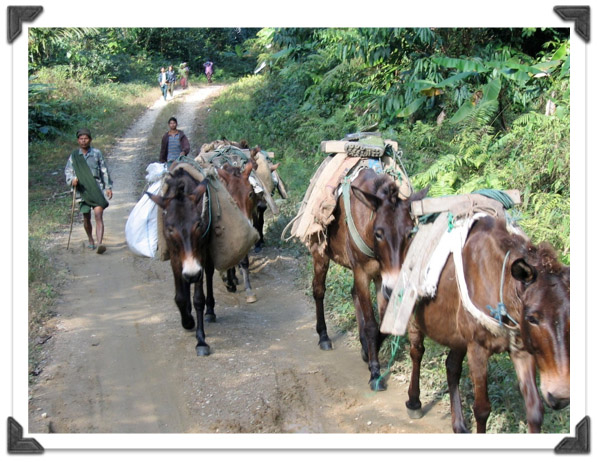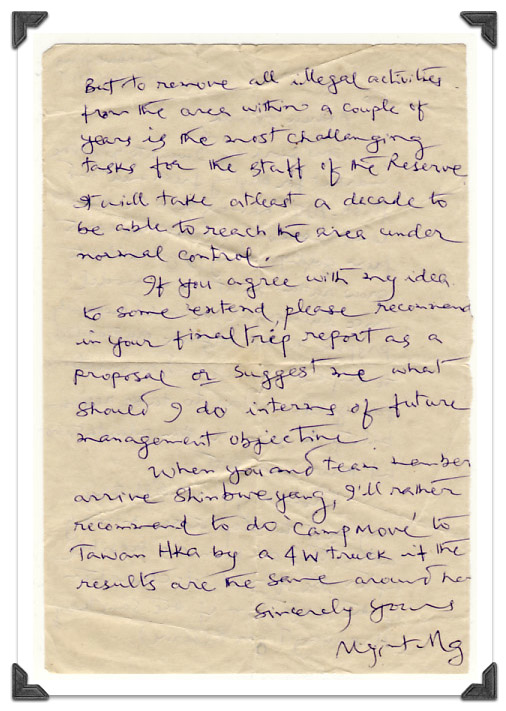Mile 21 Camp, 8:53 AM
Today could be called "waiting for the elephants". We are planning to move to a camp at Mile 15, but we can't do so until the elephants arrive, and it's anybody's guess as to when that might happen. In the meantime, it's Sunday morning, the sun is out and blazing, I've put on a new pair of pants and socks, re-packed my bag, put the solar panels on top of the tent to charge my camera batteries, taken my maleria medicine, and have opened the windows on the tent to air it out a little. I'm actually looking forward to a slow, realxing morning to re-charge my batteries. A Sunday New York Times would be nice...
Mile 15 Camp (N26º30', E96º12'), 5:54 PM
I am writing this by candlelight in my tent that has recently been set up and arranged on Mile 15. It has started to sprinkle slightly, but I don't think it is anything to worry about. The kitchen crew is building a bamboo kitchen and sleeping quarter. Amazing how quickly they can find the canes, cut them the right length, tie them together in the right place and the right order, cover the whole thing with a big sheet of plastic, and "presto" - instant shelter.
There was a change of plans today. Andrew went to look for for palms and Saw Lwin went orchid hunting in the morning. Everyone else was just taking it easy around camp waiting for the elephants to arrive. About 11:00 AM, we talked with some people on a scooter who had come from Namyun and found out that our elephants had only recently left there. It would take them about 7 hours to reach us, making it about 6:00 PM when they arrived - already dark and too late to start walking to mile 15. Shortly after the scooter left, we saw a mule train with seven mules, empty of baggage, pass by camp. About 20 minutes later, Saw Lwin returned from orchid hunting and told us that he he had talked to the man with the mules, who was headed to Shimbweyeng, and that he would gladly pack our things to Mile 15. When the elephants finally did arrive, they could rest at Mile 21 and then continue on to Mile 15 the next day, i.e. tomorrow. We thought this was a great idea, so we packed up our stuff, had a quick lunch, loaded up the mules (hard to believe how much they can carry), and started walking the six miles to Mile 15 camp. It was about 2:00 PM when we left.

As we passed the rattan camp down the road where we stopped yesterday, Andrew saw a dead Plectocomia rattan and wanted to see if maybe it had flowers and we could collect it. This was the species that our elephant, Aumbu, had helped us collect outside of Shimbweyeng (see More Myanmar). A bit of botanical background. Plectocomia is hypaxanthic, i.e. it flowers and fruits and then dies. As a result, vary rarely do you see Plectocomia plants with leaves and flowers and fruits. The original description of the species Plectocomia assamica was done by Griffith in the 1830's based on a handful of fruits collected in Assam, India. He never saw the leaves or the plant. The specimen that we collected at Shimbweyeng was sterile, a fantastic collection given how little is known about this palm, but we really needed some reproductive material, even old inflorescences or fruits.
This is what Andrew had noticed behind the rattan camp. Two rattan harvesters hiked up the mountain to try to collect it, but they could not pull the rattan down. The local name for the species, "elephant cane", refers to the enormous size of the stem, but it is also appropriate because apparently you have to have an elephant to collect a specimen of it. We saw another dead Plectocomia with old inflorescences on the other side of the road, and the collectors valiantly tried to get it, but again, they simply could not pull the rattan cane down out of the tree. We had already spent too much time on this and the sun was getting lower and lower in the sky and we were still a long way from Mile 15, so, very disappointed, Andrew and I gave up and started back walking. It is important to note that this would have been the first full collection ever of this enormous palm, and only the second collection of reproductive material. It would have been a fantastic score.
The walk back to Mile 15 passed through some beautiful forest which comes right down to the road. Perfect for transects. Beautiful rivers and old bridges. The team spread out as we walked down the road, and, as usual, I was one of the ones in front. After about two hours of walking, I rounded a curve in the road and one of the field crew was standing at the side of the road waving his arms at me. I walked over to see what he was pointing at. Right near the side of the road was a huge Plectocomia with four large, fresh infrutescences! They were ripe and bright red. The plant would soon be dead, but for now it had fresh leaves and fruit - a perfect collection. We spent about 15 minutes trying to get it and couldn't pull it down, but we couldn't spend any more time on it because it was getting dark. We marked the spot, however, and will be back first thing tomorrow with all the crew and all the time we need to make a complete collection.
We fell back into walking mode after this wonderful find, and soon the mules passed with our stuff and before long I was, again, all by myself trudging up and down the hills of the Ledo Road. Most of the assistants were in front of me with our stuff, and most of the survey team was behind me. I had no idea how far I had walked or how much further I needed to walk. I was just enjoying the scenery, savoring the discovery of the Plectocomia, and listening to the jade pendant rhythmically slap the back of my pack. After climbing one long hill and thinking that it would really be nice to be lounging in my sleeping bag, I noticed a plume of smoke down around the bend. The crew had made it to Mile 15 and started the cooking fires. I had arrived - and there was still enough time to set up my tent. Mile 15 camp is nestled in closed forest right next to a big river with a wonderful bathing spot. It is extremely picturesque and a perfect spot for camping. My tent is pitched on a slight downward slope, but I'm thrilled to have such a comfortable place to sleep, such an historic palm collection to make tomorrow, and such prime forest for running transects. The rain is continuing, slight but steady, but hopefully it want interfere with the fieldwork. Time to go see what's happening with dinner.
8:07 PM (con't)
I'm back in the tent after a wonderful dinner of beef curry and a tasty, but inknown soup. We all ate together in the lean-to that the kitchen crew had made. Very smoky if you stood up, but cozy. A perfect closing for the day. New place, new shelter, the sound of the rain, the mountain chill, the expectation of that Plectocomia tomorrow...
8:22 (con't)
One thing I forgot to mention. Shortly after leaving the camp at Mile 21 this afternoon, we passed a truck full of people. (After several days of rain the traffic had picked up again). The truck stopped and one of the passengers got out, ran directly to me, and graciously offered me a neatly folded piece of paper. It was a letter from Myint Maung (shown below). He had thought about what we had discussed and wanted to propose the idea of rehabilitating old gold mine sites with rattan plantations to the Forest Department.
